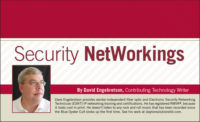
Outside of looking at new products and greeting old friends, trade shows like ISC West provide an excellent opportunity for physical security industry personnel to gain detailed, up-to-the-minute information on the new technologies and opportunities that are flooding our business. I highly recommend that security professionals who want to stay “on their game” in our changing environment make plans now to attend next year’s ISC West or the ISC East that will be held later this year in New York. Don’t forget to sign up for one of the training program packages available.
Here are some highlights from my wanderings at the show:
Ethernet Switches for IP Video
Although IP cameras and video encoders can be obtained in a vast variety of configurations, the network switches to which they are connected are not optimized to protect the integrity of the video signals or to monitor them for functionality. Our industry needs purpose-built Ethernet switches that provide specific control and monitoring features, while retaining the standardized aspects that will allow them to be seamlessly connected to larger enterprise networks.American Fibertek (AFI) is one of the companies bringing out managed Ethernet switches specifically designed for IP security use. Jim McLaughlin of AFI took me through the features of their Commander family of network switches, which should be available as soon as July. These devices provide all the features of a high-end network switch including multicast support, VLAN capability, SNMP, and Gigabit bandwidth. These switches come configured out of the box to function without any programming.
What makes these devices so important is how they can be managed, and their features for monitoring video feeds from IP cameras and encoders. Each Commander can be accessed via a web browser and is remotely manageable.
The Commanders can monitor the bandwidth flow from a specific IP video device through the switch. Called “net flow monitoring,” the Commander will watch the video flow in 10-second intervals, looking to see whether the amount of video drops below a user-specified threshold. E-mails and alarms can generate when such events occur.
PoE
We will soon be saying goodbye and good riddance to plug-in transformers and separate power supplies for IP video devices. Graham Joys of Vista Networking Solutions gave an excellent talk on the hows and whys of Power over Ethernet (PoE). Industry-standard 802.3af PoE provides a plug-and-go powering function, with 48 volts and 13 watts of power being potentially available to every device connected to a PSE (Power Sourcing Equipment)-enabled network port.PoE will transform the installation of security cameras. Now we have a one-cable solution that can provide video data connection and power to a maximum distance of 100 meters between the PSE switch and the PoE-enabled device, also termed a PD (Powered Device). We don’t have to look for AC power outlets near a proposed camera location, and don’t have to deal with the dangers and difficulties of connecting to high-voltage AC power. Also, PoE will work on inexpensive and existing Cat 5 (or better) UTP cable, whose thin diameter can be pulled through the smallest of conduits.
While the 802.3af standard provides up to 13 watts of power, this is not enough juice to operate PTZ cameras, which normally require 20+ watts. The great news is that the IEEE (Institute of Electrical and Electronic Engineers) is preparing a new PoE standard, called 802.3at, which is “PoE Plus.” Backwards compatible to 802.3af equipment, PoE Plus will provide up to 30 watts of power on each port, making outside PTZ cameras a one-cable installation. This standard is likely to be approved within the next year, and vendors are already gearing up their products to take advantage of it.

Sidebar: Web Site of the Month
www.networkcamerareviews.comThis free Web site has connections and links to cameras from a variety of vendors. Dealers can see the actual image qualities of the cameras.



